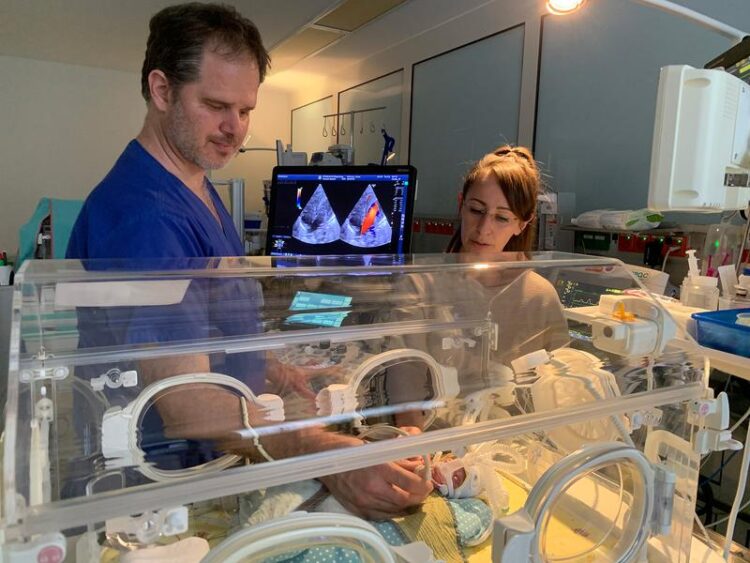Artificial intelligence detects heart defects in newborns

Pediatric cardiologist Dr. Holger Michel during a cardiac ultrasound examination of 7-week-old Jarmo in the presence of his mother.
Photograph: Sven Wellmann / KUNO Klinik St. Hedwig in Regensburg
Many children announce their arrival in the delivery room with a piercing cry. As a newborn automatically takes its first breath, the lungs inflate, the blood vessels in the lungs widen, and the whole circulatory system reconfigures itself to life outside the womb. This process doesn’t always go to plan, however. Some infants – particularly those who are very sick or born prematurely – suffer from pulmonary hypertension, a serious disorder in which the arteries to the lungs remain narrowed after delivery or close up again in the first few days or weeks after birth. This constricts the flow of blood to the lungs, reducing the amount of oxygen in the blood.
Prompt diagnosis and treatment improve prognosis
Severe cases of pulmonary hypertension need to be detected and treated as rapidly as possible. The sooner treatment begins, the better the prognosis for the newborn infant. Yet making the correct diagnosis can be challenging. Only experienced paediatric cardiologists are able to diagnose pulmonary hypertension based on a comprehensive ultrasound examination of the heart. “Detecting pulmonary hypertension is time-consuming and requires a cardiologist with highly specific expertise and many years of experience. Only the largest paediatric clinics tend to have those skills on hand,” says Professor Sven Wellmann, Medical Director of the Department of Neonatology at KUNO Klinik St. Hedwig, part of the Hospital of the Order of St. John in Regensburg in Germany.
Researchers from the group led by Julia Vogt, who runs the Medical Data Science Group at ETH Zurich, recently teamed up with neonatologists at KUNO Klinik St. Hedwig to develop a computer model that provides reliable support in diagnosing the disease in newborn infants. Their results have now been published in the International Journal of Computer Vision.
Making AI reliable and explainable
The ETH researchers began by training their algorithm on hundreds of video recordings taken from ultrasound examinations of the hearts of 192 newborns. This dataset also included moving images of the beating heart taken from different angles as well as diagnoses by experienced paediatric cardiologists (is pulmonary hypertension present or not) and an evaluation of the disease’s severity (“mild” or “moderate to severe”). To determine the algorithm’s success at interpreting the images, the researchers subsequently added a second dataset of ultrasound images from 78 newborn infants, which the model had never seen before. The model suggested the correct diagnosis in around 80 to 90 percent of cases and was able to determine the correct level of disease severity in around 65 to 85 percent of cases.
“The key to using a machine-learning model in a medical context is not just the prediction accuracy, but also whether humans are able to understand the criteria the model uses to make decisions,” Vogt says. Her model makes this possible by highlighting the parts of the ultrasound image on which its categorisation is based. This allows doctors to see exactly which areas or characteristics of the heart and its blood vessels the model considered to be suspicious. When the paediatric cardiologists examined the datasets, they discovered that the model looks at the same characteristics as they do, even though it was not explicitly programmed to do so.
A human makes the diagnosis
This machine-learning model could potentially be extended to other organs and diseases, for example to diagnose heart septal defects or valvular heart disease.
It could also be useful in regions where no specialists are available: standardised ultrasound images could be taken by a healthcare professional, and the model could then provide a preliminary risk assessment and an indication of whether a specialist should be consulted. Medical facilities that do have access to highly qualified specialists could use the model to ease their workload and to help reach a better and more objective diagnosis. “AI has the potential to make significant improvements to healthcare. The crucial issue for us is that the final decision should always be made by a human, by a doctor. AI should simply be providing support to ensure that the maximum number of people can receive the best possible medical care,” Vogt says.
Journal: International Journal of Computer Vision
DOI: 10.1007/s11263-024-01996-x
Article Title: Deep Learning Based Prediction of Pulmonary Hypertension in Newborns Using Echocardiograms
Article Publication Date: 6-Feb-2024
Media Contact
Peter Rueegg
ETH Zurich
peter.rueegg@hk.ethz.ch
Office: 446-324-532
Media Contact
All latest news from the category: Information Technology
Here you can find a summary of innovations in the fields of information and data processing and up-to-date developments on IT equipment and hardware.
This area covers topics such as IT services, IT architectures, IT management and telecommunications.
Newest articles

A universal framework for spatial biology
SpatialData is a freely accessible tool to unify and integrate data from different omics technologies accounting for spatial information, which can provide holistic insights into health and disease. Biological processes…

How complex biological processes arise
A $20 million grant from the U.S. National Science Foundation (NSF) will support the establishment and operation of the National Synthesis Center for Emergence in the Molecular and Cellular Sciences (NCEMS) at…

Airborne single-photon lidar system achieves high-resolution 3D imaging
Compact, low-power system opens doors for photon-efficient drone and satellite-based environmental monitoring and mapping. Researchers have developed a compact and lightweight single-photon airborne lidar system that can acquire high-resolution 3D…





















